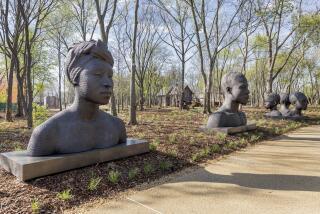Solomon Northup’s story is largely unknown in his New York hometown
SARATOGA SPRINGS, N.Y. — In the film “12 Years a Slave,” free black man Solomon Northup dreams of one thing during his long captivity in the antebellum South: returning to his family and home in Saratoga Springs.
In the film, as Northup, played by Chiwetel Ejiofor, undergoes grueling labor and horrific punishment on a series of Southern plantations, Saratoga Springs becomes a promised land, its name uttered with a sense of longing and hope.
Yet mention Northup’s name to many locals in modern-day Saratoga Springs or ask about the memoir or movie that tells his story and they’ll raise an eyebrow, largely unaware of the man and his legacy.
“I’ve never met him. But I think my daughter has,” said Linda Gibeault, 63, a manager at a downtown motel. When told who Northup was, she said, “That’s fascinating. I’ve never heard of him, and I’ve been here 34 years. But people don’t like to talk about things like that here. Especially Republicans. And I’m a Republican.”
VIDEO: Watch ’12 Years a Slave’ cast and crew discuss film
As the Steve McQueen film continues to draw critical acclaim and audiences — since hitting theaters in October, the movie has grossed more than $40 million and has been nominated for nine Oscars, including best picture — it has renewed focus on the racial history of the slave-holding South. And nearly 150 years after the end of the Civil War, the North’s attitude toward slavery is also coming under scrutiny.
“New York and some other Northern states don’t like to think of themselves as having a connection to slavery — they think of it as a Southern thing,” said David Fiske, an upstate New York-based scholar who has written several books about Northup. “Most people living in New York would be surprised to find out that slavery was still legal here as late as 1827.”
Northup moved with his wife, Anne, from their farm in nearby Kingsbury to Saratoga Springs in 1834. The free-born Northup was a violinist and a driver, raising his three children in relative prosperity for the next seven years. In 1841, with the false promise of a job in a circus, he was lured by several kidnappers to Washington, D.C., where he was sold into slavery before finally regaining his freedom 12 years later.
Situated about three hours north of New York City, this upstate town of 26,000 is these days an upscale, educated community, with liberal-arts Skidmore College in the middle of town and trendy shops lining its main streets. The Saratoga Race Course, which dates back to the 1860s, is a well-known attraction. Yet Northup’s 1853 memoir is not taught in schools here. Nor is there an exhibit devoted to the antislavery crusader at the downtown history museum.
PHOTOS: Scenes from ’12 Years a Slave’
And an annual summer event started more than a decade ago by a local African American woman to commemorate the town’s native son resulted in a partisan dispute with the mayor’s office, which in 2013 barred the event from taking place at the town’s main event space.
“There is a population that wants to celebrate the city and its different aspects,” said Joanne Yepsen, a Democrat who was serving as a county supervisor when the event was barred last summer and who was recently elected mayor. “But some of our leaders have different priorities.”
To be fair, until the past decade even some historians were unaware of Northup’s tale, and the book had been largely forgotten. But the ignorance is particularly pointed in Saratoga Springs, which can claim Northup as one of its true native heroes.
Renee Moore, founder of Solomon Northup Day and the city’s chief proponent of marking its racial past, knows that firsthand.
Solomon Northup Day has become a magnet for those with a connection to the man — last year, several dozen of his descendants gathered for the event at Skidmore College and the film’s co-star and Oscar nominee Lupita Nyong’o turned out to speak, while footage was shown; one descendant, Clayton Adams of Pittsburgh, described the experience “like watching ‘Lincoln’ with all the people from the film there.”
REVIEW: McQueen’s ’12 Years a Slave’ impressive, and hard to watch
But Moore has often struggled to raise even the few hundred dollars necessary to finance the proceedings. Local businesses eventually contribute, and she usually gets a small grant from an upstate charity. The city does not contribute.
From a dilapidated row house just a few blocks from the town’s main street, Moore, who was raised here, lays packs of Northup-related material in her living room. “Solomon Northup, one of the great heroes of the slavery era, is from here, but you wouldn’t know it from listening to our mayor,” she said.
Moore, a feisty fiftysomething who is one of the city’s roughly 1,000 black residents, came up with the idea for the event nearly 15 years ago after an exhibit at Union College in nearby Schenectady turned her on to Northup’s story.
Among those she holds responsible for the challenges is former Deputy Mayor Shauna Sutton, a Republican who oversaw city events in Saratoga Springs. Moore said that Sutton never attended Solomon Northup Day events and that she didn’t allow it to be held at its usual spot at the visitors center last year.
“There are a lot of people here who view blacks the way certain people from Texas or Arizona view Mexicans: as a kind of contagion that’s percolating north, in this case from New York City,” said Enid Mastrianni, an Italian American who has helped Moore with the event since 2002. “So to acknowledge Solomon Northup is to wreck their narrative. It means black people were here long before they were.”
PHOTOS: Winter movie sneaks 2014
That race-fueled tension is bubbling up in the city in other ways too. A blog called Saratoga in Decline has recently been calling attention to alleged injustices by the police against the city’s minority population, using graphic photos and headlines like “Guilty of Being Black in Saratoga Springs.”
In August, a 21-year-old black man named Daryl Mount was seriously injured while being pursued by police. As Mount has languished in a coma, protesters have ratcheted up calls for an independent investigation. Police have said he was hurt while climbing scaffolding.
Sutton did not return a call for comment about Northup Day, and a call to the office of former Mayor Scott Johnson, a Republican, led to a referral to Ken Klotz, a former Democratic mayor who was instrumental in the early years of the Northup commemorations.
Part of the problem, say those who have tried to honor Northup, is that there isn’t much left that can be tied to him. Nearly all the buildings from that era have been razed. There is also no known grave site for Northup and few artifacts, which is why officials say the town’s main history museum contains no mention of him, focusing instead on periods like the community’s resort-town heyday of the mid- to late 19th century.
Still, Moore fought to get a plaque at the visitor’s center. A few years ago, she prevailed.
BEST MOVIES OF 2013: Turan | Sharkey | Olsen
There are other signs the tide is turning. Last year, a city reading program recommended “12 Years a Slave” as the title residents should read and discuss.
Tab Orthwein, a Saratoga Springs woman who helps organize the event, said she heard from many who chose to read the book. “People were shocked by what had happened, and that they didn’t know about it,” she said.
A new multiplex in town had been playing the film, which has created enough awareness that Skidmore College appears poised to pitch in with Solomon Northup Day and perhaps even take it over entirely, Moore said.
“Maybe the movie will make things better, maybe [Mayor] Joanne [Yepsen] will make things better,” Moore said. “But people here don’t really seem to care. Talking about Solomon Northup, you can feel like you’re shouting into the wind.”
More to Read
Only good movies
Get the Indie Focus newsletter, Mark Olsen's weekly guide to the world of cinema.
You may occasionally receive promotional content from the Los Angeles Times.







